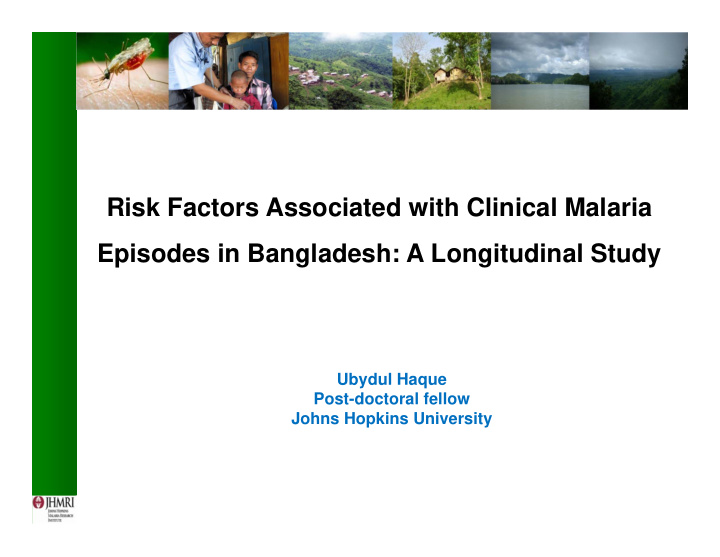



Risk Factors Associated with Clinical Malaria Episodes in Bangladesh: A Longitudinal Study Ubydul Haque Post-doctoral fellow Johns Hopkins University
District map of Bangladesh showing the Pf PR 2–10 from the 354 villages geo-located and the location of Bangladesh , Am. J. Trop. Med. Hyg., 83(4), 2010, pp. 861–867
Median predicted spatial distribution of Pf PR 2–10 across the endemic thanas of Bangladesh at 1- × 1-km resolution, upper 75% predicted prevalence (Upper Inset), and lower 25% predicted prevalence (Lower Inset), Am. J. Trop. Med. Hyg., 83(4), 2010, pp. 861–867
Study area Incidence of reported cases of Plasmodium falciparum and Plasmodium vivax per 1,000 people across the endemic sub-districts in Bangladesh, 2007. Malaria Journal 2012, 11:170
Study area
Objective This study investigates bed net ratio per household, housing construction materials (wall), hydrologic and topographic risk factors of malaria, and spatial patterns of the disease over two years in the same population.
Data collection • Malaria episodes of 1634 households (all age groups) in 2009 and 2010 • Diagnosis • Socioeconomic • Geographic • Household density calculation • Remote sensing data
Analysis Examine individual and household level analyses with malaria incidence by spatial and statistical analysis. Multivariate negative binomial regression model • Association between malaria incidence with socioeconomic, topographic and hydrological risk factors. Spatial analysis • Detect spatial clusters of malaria episodes
Results – Overall Patterns Malaria incidence • There were 497 (6.3%) episodes of malaria recorded from 7,922 individuals during the study period. • 78% households did not experience any malaria, 252 households (15%) had one single malaria case and 104 households (6.4%) had multiple infections, i.e. two to five infections. Individual level risk factors: • Using children <5 years as reference (Incidence rate ratio, IRR: 1) the risk of malaria infection decreased with increasing age. • Malaria was equally distributed among males and females in the population.
Stream order network in the study area, Bangladesh
Malaria risk increased in households having lower bed net coverage, poor housing materials and high house density Risk factors for malaria* Factor Adjusted IRR (95% CI) P Bed net ratio (per person/per household) IRR (95% CI) IRR (95% CI) 0–0.5 1 > 0.5–1 0.71 (0.56–0.91) 0.006 > 1 0.42 (0.28–0.62) 0.0001 Wall Jute stick/bamboo 1 Tin/concrete 1.63 (0.94–2.82) 0.081 Mud 2.17 (1.45–3.26) 0.0001 House density (no.) 1–200 1 201–500 1.80 (1.09–3.00) 0.022 501–1,000 1.43 (0.70–2.92) 0.326 > 1,000 2.79 (1.70–4.56) 0.0001 *IRR = incidence rate ratio; CI = confidence interval. IRR for the reference category is 1.00. Only significant risk factors are shown
Clusters Clusters Figure. A, Spatial distribution of malaria clusters in 2009. B, Spatial distribution of malaria clusters in 2010.
Limitations • Thirteen confirmed cases were excluded because their names and households did not match with our records. • There could have been false-positive or false-negative results in microscopic tests or RDTs • Missed some malaria-positive cases, e.g., if persons bought antimalarial drugs directly from drug vendors and/or preferred self treatment
Conclusion • This longitudinal study provides some novel findings about stability of hot spots and multiple infections among households and individuals. • Further, the areas that require expanded malaria control efforts based on malaria foci have been identified. • The location of households in villages is an independent and important factor for variation in malaria incidence. • This study also confirmed the existence of some malaria risk factors (bed net ratio, poor housing construction materials and house density) • Mass screening can be conducted in stable hotspots to identify asymptomatic reservoirs and providing treatment • For targeted interventions, detail risk mapping using GIS, remote sensing, and DEM may be important for policy implementation.
Recommend
More recommend